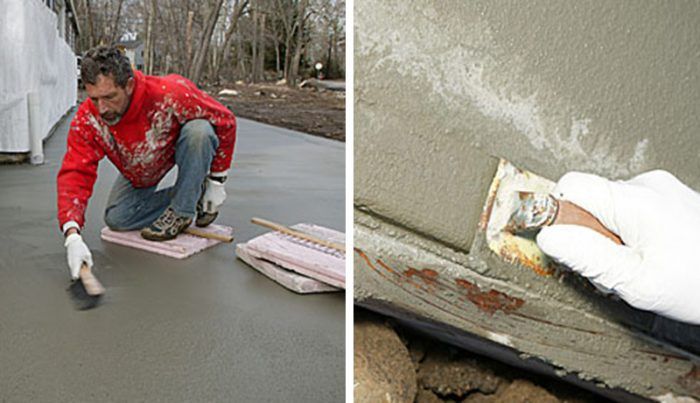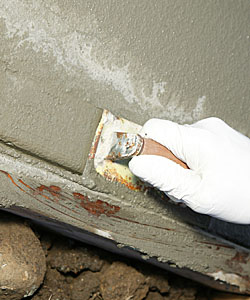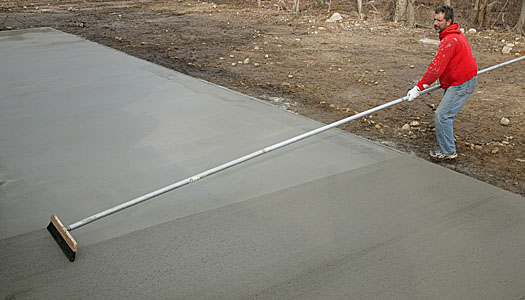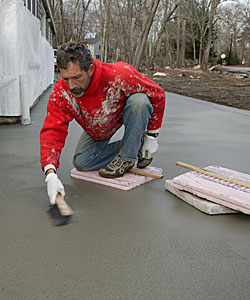How to Finish a Concrete Patio Slab
Get the perfect texture with these easy steps, whether you want your patio to be coarse or smooth.

Exterior slabs look good with any number of finishes. Broomed, brushed, floated, and troweled finishes are the easiest. You need to walk on the slab, so to minimize imprints, use kneeboards, pieces of plywood about a foot and a half square with a 1x handle attached with screws. For more comfort, I make kneeboards out of 2-in.-thick rigid foam. You need three boards so that you can shuttle the free one in your direction of travel.
The first step is to score (concrete guys say “strike”) control joints with a jointer. Then decide what kind of finish is best, and pick a broom or trowel.
Stiff-bristle brooms leave the most aggressive texture, always a good choice for walkways. A swirl pattern is a variation of brooming and is done with handheld brushes.
A float or trowel finish is nice for patio slabs where an aggressive pattern would be too tough on bare feet. A bull float or handheld magnesium float can be passed over the surface again. This time, floating will further smooth the fines on the surface and close bubble holes from the first float. Sand grains will stand proud on surface for a smooth-looking but slip-resistant finish.
After the slab is finished, don’t let anybody or anything walk on the delicate surface for two or three days.
Concrete finishing techniques:
For a coarse texture, use a stiff broom. With a broom end attached to a long aluminum pole, pull the assembly over the surface once and reposition it with little or no overlap next to the previous draw. It’s a good idea to rinse off the bristles with a hose after each pass, or to knock the broom against a clean board.
Use a softer brush for a swirl pattern. I use a hand broom to sweep consistent swirls on the slab surface. You need to get on the slab with kneeboards. As you go, smooth any depressions from the boards with a magnesium float before brushing. The trick is to maintain consistent swirl patterns across the slab.
Magnesium and steel make the smoothest, hardest surface. Work a steel trowel in combination with a magnesium float in arcing strokes across the surface. Pass the float across an area to loosen up the cream a little and to knock down stones just under the surface. Then run a steel trowel over the area at a slight feather to leave a shiny, flat surface.
 |
 |
The last touch. The final step for any finish is to ease the perimeter of the slab with an edging tool, gliding the edger along the outside form.
An ounce of prevention, a pound of cure
Aside from kids and dogs, drying out and freezing are the concrete worker’s biggest concerns. The slab must be kept wet to cure properly. If the concrete dries too fast, it will be weak, it will crack, and the surface will spall. Spraying the slab with a hose is the best, simplest method to keep it wet, but it’s also time-consuming, especially in hot, dry conditions. I use a misting approach to cover the slab gently and evenly. Misting might need to be done only twice a day if the weather is cool or damp; if it’s hot and dry, you might need sprinklers.
On the other hand, if you poured during winter, the water inside the concrete can’t be allowed to freeze for a week, or it won’t cure. Fresh concrete can handle temperatures slightly below freezing; a short dip overnight below 32°F won’t be a problem, but if the daytime highs don’t go above freezing, watch out. Covering the slab with plastic and spreading a 4-in.-thick to 6-in.-thick layer of straw over the top will help to retain the heat generated in the curing concrete and reduce the chance of freeze damage.
—Contributing editor Mike Guertin is a builder and remodeling contractor from East Greenwich, R.I. His Web site is www.mikeguertin.com.
Photos by: Charles Bickford
To learn how Mike Guertin poured this patio before finishing it, read Tips for Pouring a Concrete Slab from Fine Homebuilding issue #194 (April/May 2008), pp.82-85.








View Comments
That's one mighty big slab that you're laying there, Mike. Nothing about expansion joints or saw cuts?